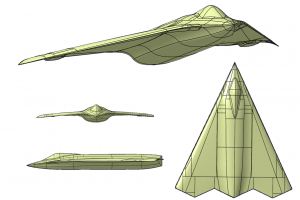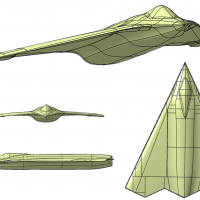This project was setup as a collaboration between the Control & Simulation division and Lockheed-Martin Skunkworks. The Innovative Control Effectors (ICE) aircraft concept was developed by Lockheed-Martin Skunkworks to investigate new flight control and control allocation approaches. A detailed dynamic model of ICE implemented in Matlab/Simulink has been made available by Lockheed-Martin for this research project. This model was developed based on Computer Fluid Dynamics (CFD) and wind tunnel data, and consists of up to 5-dimensional data tables for the aerodynamic stability and control derivatives. ICE has a total of 13 control effectors which is much more than comparable (fighter) aircraft. The control effectors of ICE are strongly redundant, and more importantly, also non-linearly influence each others functions.
 Control allocation is an optimization problem in which a combination of control effector deflections are calculated that meet a specific aerodynamic force or moment demand. For conventional aircraft, the control allocation problem can be solved using standard methods such as the pseudo-inverse method. For ICE, however, the large number of non-linearly coupled redundant control effectors results in a much more challenging control allocation problem.
Control allocation is an optimization problem in which a combination of control effector deflections are calculated that meet a specific aerodynamic force or moment demand. For conventional aircraft, the control allocation problem can be solved using standard methods such as the pseudo-inverse method. For ICE, however, the large number of non-linearly coupled redundant control effectors results in a much more challenging control allocation problem.
The goal of this project is to investigate new approaches to solving the ICE control allocation problem. Current research directions are based on efficient active set algorithms, and non-linear control allocation approach that requires the ICE aerodynamic model to be parametrized using multivariate splines.
A recent outcome of the research is the Incremental Nonlinear Control Allocation (INCA) approach. This approach can handle nonlinear control effector interactions as well as actuator dynamics and constraints. INCA has superior performance over all linear control allocation approaches. INCA for the first time allows control of all 13 control effectors of ICE in a real-time setting.
Current research directions are combining INCA with flight envelope prediction and protection. In addition fault-tolerant and adaptive versions of INCA are researched that can handle structural failures.


